The planet Mercury will provide one of the most arresting celestial sights of 2019 when, on Monday 11 November, it will pass across the face of the Sun. The Transit of Mercury is an event that’s among the rarest of predictable astronomical phenomena. For observers in the UK the event will begin around 12.35pm and continue past sunset, at around 16.22pm.
Even though the UK won’t get the best view of the event, it will be well worth trying to observe it through a solar telescope, not least because you don’t need to witness the whole thing; a short observation will do (and with 75% chance of cloud cover in mid-November that’s probably a realistic goal).
But also because it won’t happen again until 13 November 2032.
Mercury’s trip across the Sun isn’t the only transit we get to see. A more famous event is the transit of Venus, which last occurred in 2012.
But even if you consider the transit of Mercury to be a smaller and less impressive affair, it’s something of a moot point since the next transit of Venus doesn’t take place for another 98 years.
Besides, observing the transit of Mercury can be just as rewarding.
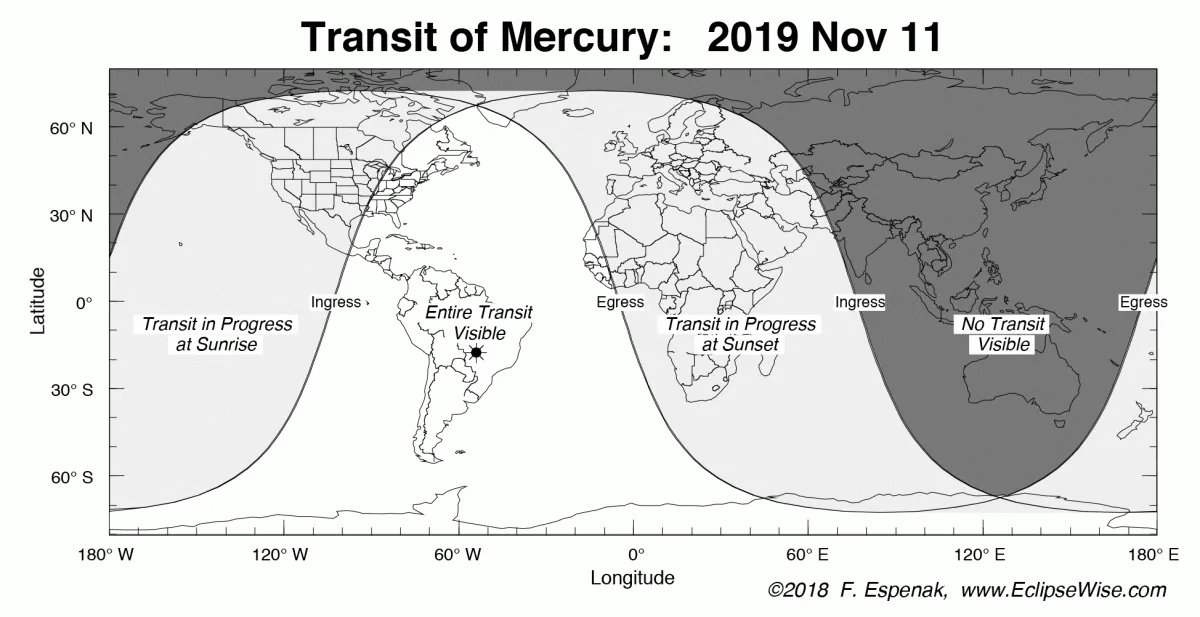
What can be seen during a Transit of Mercury?
The tiny black disc of Mercury, just 10 arc seconds across, will take about five and a half hours to pass across the Sun. It will cross from east to west.
“I thought it was going to be a very small dot because Mercury is 1/150th the diameter of the Sun, and I thought there was no way I would see it with my three-inch refractor,” says Eric Emms, an amateur astronomer and member of The Baker Street Irregular Astronomers in London, who observed a previous transit.
“I was surprised at how big and dark its disc was as it moved across the surface of the Sun – it was amazing!”
Xavier Jubier, an eclipse-chaser from Paris, France and a member of the IAU Working Group on Solar Eclipses found another way to view Mercury’s last solar transit.
“It’s actually visible to the naked eye with solar eclipse glasses,” he says. “Although the apparent diameter of Mercury is much smaller than Venus, which means that without enough magnification it’s more difficult to observe.”
He recommends using a telescope with a focal length of 1,000mm, though any smaller telescope will get you a view of Mercury as a tiny black dot.
“Simple and inexpensive solar scopes can also be used,” he says.
Above: the 2016 Mercury transit in 4K video. Credit: NASA Goddard
Why is a transit of Mercury interesting?
The transit of Venus is famous for helping scientists figure out the Astronomical Unit – the average distance from Earth to the Sun – by measuring where Venus appeared to be on the Sun’s disc at the same time from different places on Earth.
Telescopes have been pointed at transits of Mercury for centuries, including those at the Royal Observatory Greenwich in London.
“If you can make very accurate timing observations of the transit of Mercury it can help you to calibrate Mercury’s orbit and calculate the size of the Solar System,” says Tom Kerss, an astronomer at the Royal Observatory Greenwich.
Mercury’s orbit is inclined about 7° to the plane of the ecliptic, the Sun's apparent path during the year against the background of stars, as seen from Earth.
It was Albert Einstein who finally figured out why Mercury’s orbit didn’t entirely conform to Newton’s laws of motion: the Sun’s effect on the local spacetime causes the tiny planet to accelerate as its orbit brings it close to the star.
But long before Einstein’s Theory of Relativity solved the mystery, it was Edmund Halley, who succeeded John Flamsteed as the Astronomer Royal at Greenwich in 1720, who highlighted the importance of transits of Mercury after observing one from St Helena in 1677.
“Halley wrote papers explaining how the transits of Mercury could be used to calculate the distance between the Sun, Earth and Mercury, and the scale of the Solar System,” says Kerss.
“It’s how things like the orbits of Neptune and Uranus were determined long before the days of computers – so Mercury is very useful in that regard because it’s such a frequent transiter.”

Given how many transits of Mercury have now been observed, you’d be forgiven for thinking there’s not much left for us to learn from them.
But that’s not the case. “We can use transits of Mercury to calibrate our understanding of what exoplanet transits may look like to our instruments,” says Kerss.
Astronomers interpret a dip in brightness of a star as a successful discovery of an exoplanet and have recently moved on to try to detect exomoons.]
Mercury doesn’t have any moons (as discovered by astronomers at the Royal Observatory during a transit back in 1914) so light curves from a transit give astronomers a template of what an exoplanet looks like when it doesn’t have any moons.
On 3 June 2014, NASA’s Mars rover Curiosity observed a transit of Mercury across the Sun, marking the first time a planetary transit has been observed from a celestial body besides Earth.
Professional astronomers will be collecting data from this month’s transit of Mercury, but it’s a relatively simple sight for any amateur astronomer or stargazer to watch safely.
“Obviously you can’t look at the Sun with normal binoculars or telescopes,” says Eric Emms.
“In 2016, I used a three-inch refractor and made a solar filter to put over the objective lens using an A4 sheet of Baader AstroSolar film, which costs about £20.”
The same can be done for binoculars. “8x45 binoculars should still let you see Mercury as a dot,” says Emms.
A century of Mercury transits
On average, there are a couple of transits of Venus per century, but 13 or 14 transits of Mercury over the same period. What’s more, transits of Mercury always occur in May and November.
What makes them so oddly regular? “It’s to do with the eccentricity of Mercury’s orbit and the resonance it has with Earth’s orbit,” says Kerss.
Mercury’s apparent size changes by up to 20 per cent and that’s a function of it having the Solar System’s most eccentric orbit.
“When we see a transit of Mercury in May, it’s while Mercury is closer to Earth and so it has a 12 arcsecond disc,” says Kerss.
“In November, the transits occur when Mercury is closer to the Sun so the planet appears slightly smaller from our perspective, about 10 arcseconds.”
At 88 days, Mercury’s orbit of the Sun is almost a quarter of that of Earth, which means it’s close to being in orbital resonance with Earth, hence the transits occur at the same times of year… for the time being.
“The timing between them will drift and though they occur in May and November now, that will change in centuries to come,” says Kerss. “But they’ll always be six months apart.”
Mercury transits 2001–2100
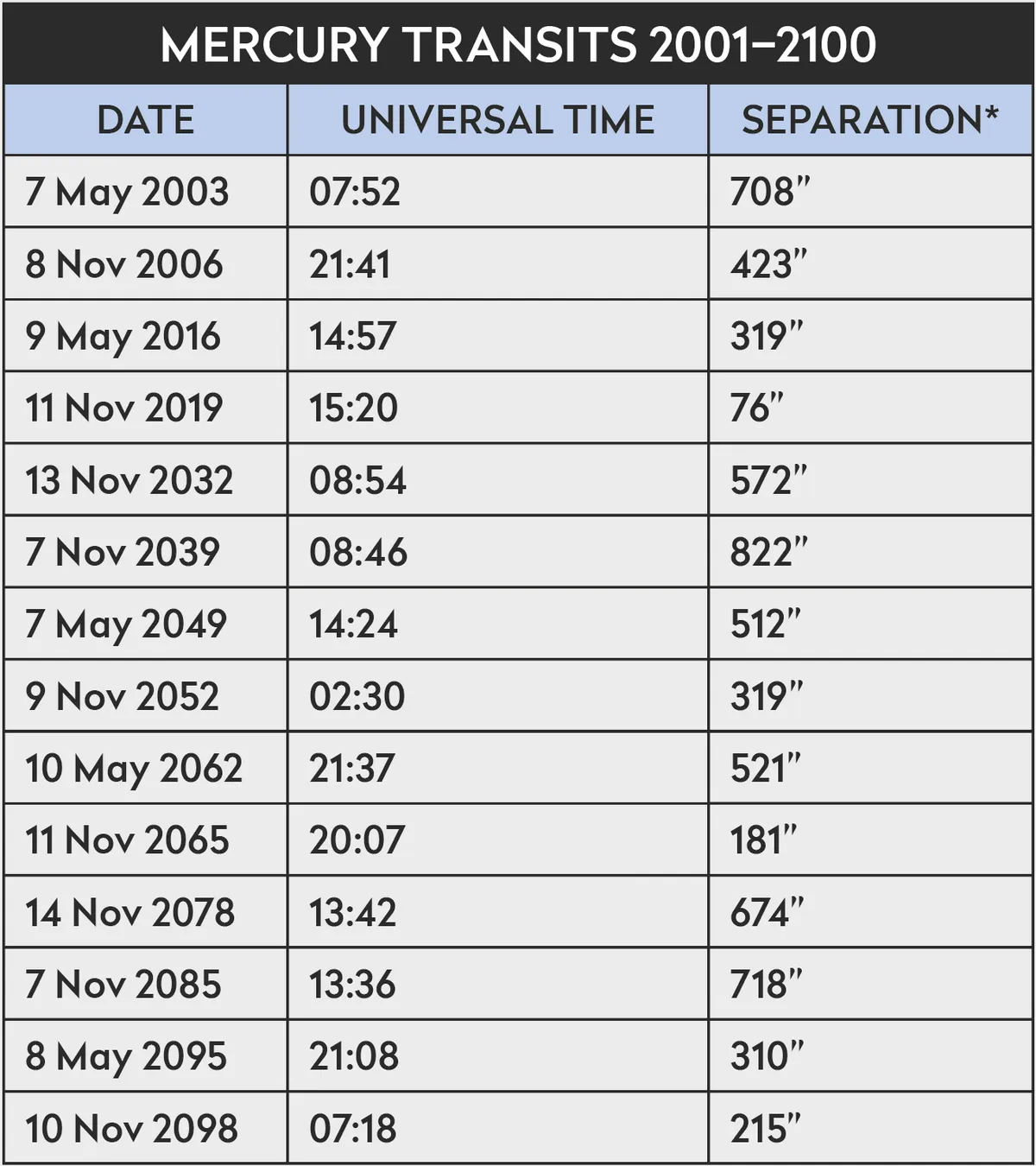
How to observe the transit of Mercury safely
It’s extremely dangerous to look at the Sun, and even more dangerous to do so through an unprotected telescope.
“Mercury is small, so this is not going to be like a total solar eclipse where you can watch the central phase, totality, without any special equipment,” says Dr Robert Massey, Deputy Executive Director at the Royal Astronomical Society and co-author ofMoon: Art, Science, Culture.
“A pair of eclipse glasses won’t help because Mercury has too small an angular size, but if you project its image through a tripod-mounted telescope or binoculars onto a piece of white card you will see the disc of the Sun and Mercury crossing it as a speck.”
Another option is to put a solar filter on the front of a telescope and observe as normal through the eyepiece, which will get you greater detail.
Baader AstroSolar filter material costs around £20 for an A4 sheet. There are more tips on observing a Transit of Mercury safely here.
Find a public event and share the experience
The best and safest option is to attend a public event at an observatory, museum or science centre, or find an observing event organised by a local amateur astronomy group.
“They’ll be set up properly, they’ll have better equipment than you, and you’ll also get the camaraderie of being with a group of people who are interested in the same thing as you,” says Massey.
Lookout for details in your area or contact your local astronomy society.
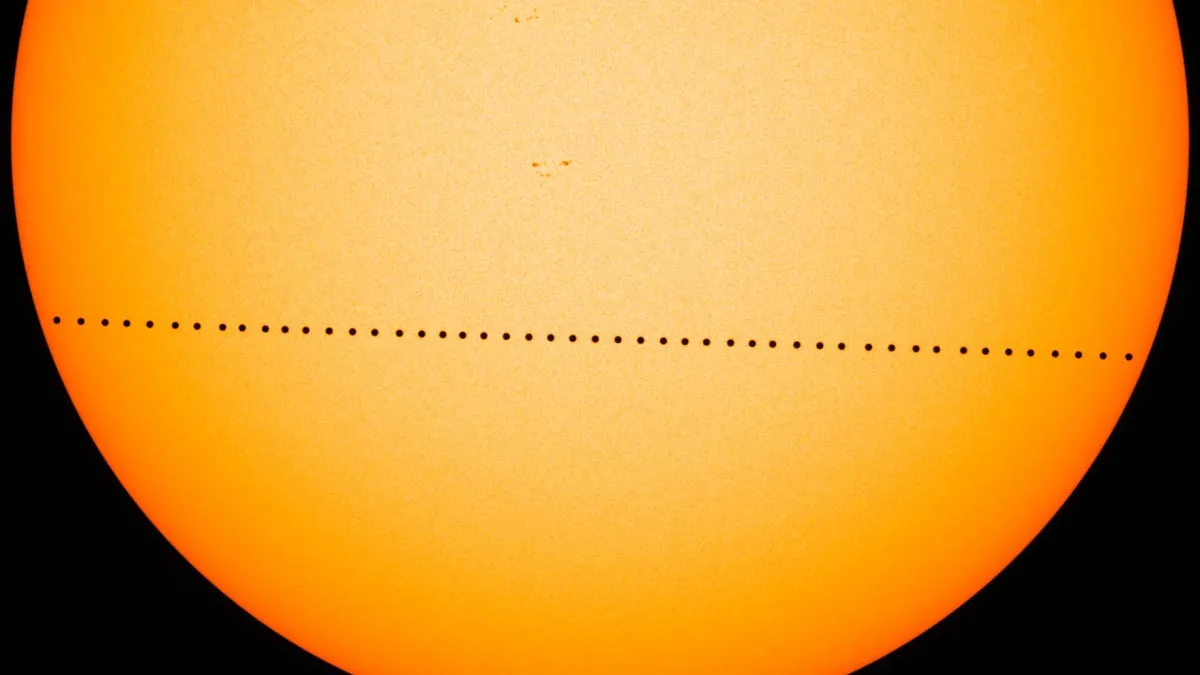
Where’s the best place to watch the transit of Mercury?
Those who travel to see a transit of Mercury do so primarily for a higher chance of clear weather, but also to watch the entire event from start to finish, as shown by this interactive Google Map.
“You can see that all of the transit is visible from the Atacama desert in northern Chile and western Africa where the weather prospects are the best in November,” says Xavier Jubier, a member of the IAU Working Group on Solar Eclipses.
“This is why I will likely observe from the Canary Islands or else from the Atacama desert in northern Chile.”
However, we’re talking independent travel; don’t expect special ‘transit trips’ to be organised.
“Mercury transits don't have the same kind of pull as eclipses, so as far as I know there aren't special trips to see them, not least because they are visible over a large area,” says Massey.
Wherever you watch from, the transit of Mercury – the last until 2032 – promises to be a special astronomical event.
How to see the Mercury transit from the UK
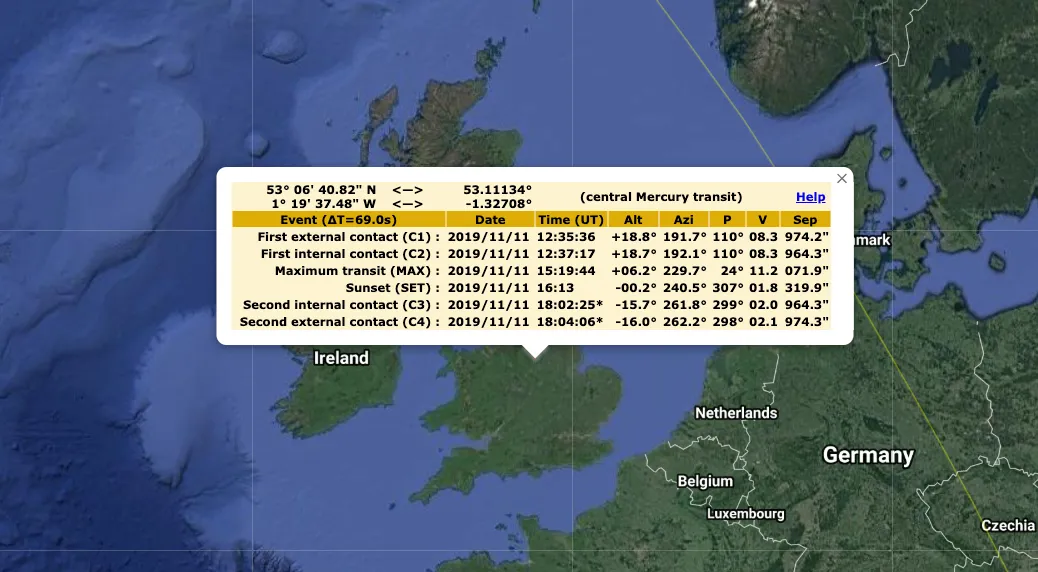
Although it's not a prime viewing spot, the transit of Mercury will be viewable from the UK during sunset.
“It’s happening at noon going forward until sunset, so the prospects are not terrible, but the Sun is rather low in the sky during November and, of course, the weather prospects are not as good as during May,” says Massey.
In the UK on 11 November 2019, the event will be begin at lunchtime and still be ongoing as the Sun sets, but the Sun will never be higher than 20° above the horizon.
However, if you want only a glimpse of the event, it will be possible … clear skies allowing.
Here’s the timetable:
UK Mercury transit times:
- 12:35 – Mercury touches the Sun's edge
- 15:19 – Mercury is nearest the Sun’s centre
- 16:15 – Sun sets with transit ongoing
(All times from www.timeanddate.com)
The best places around the world to watch the transit of Mercury
The entire transit is viewable from South America, with eastern North America and west Africa also well placed.
However, likely cloud cover make some places better than others.
1
Atacama Desert, Chile
Entire transit visible from 09:35-15:03
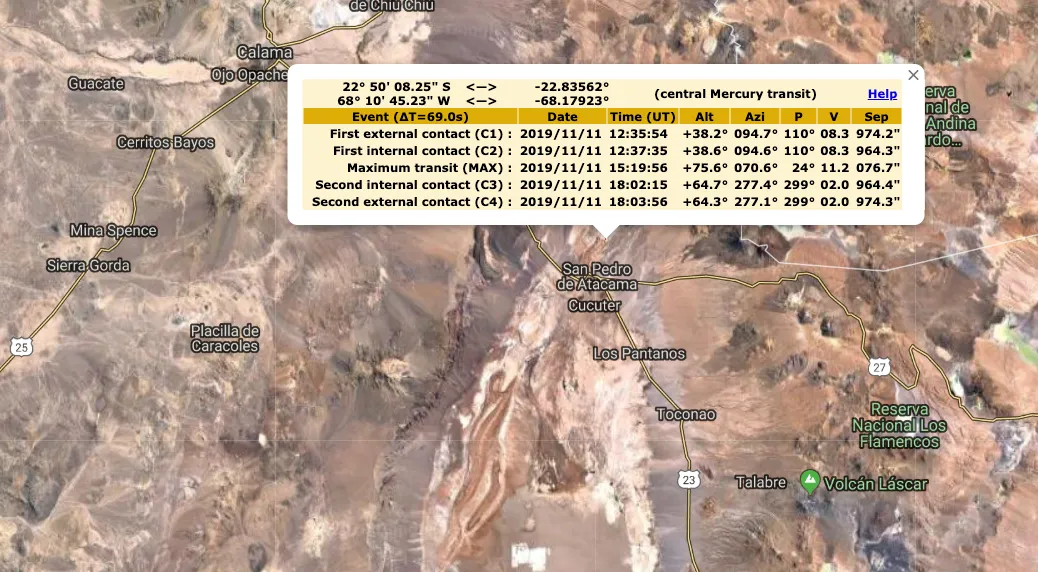
As well as having a view of the entire event and a high chance of clear skies, there are many boutique observatories around the small town of San Pedro de Atacama that will almost certainly be setting-up sun-scopes.
Try Observatorio Alarkapin and Explora Atacama, both of which host visitors.
2
Salar de Uyuni, Bolivia
Entire transit visible from 08:35-14:03
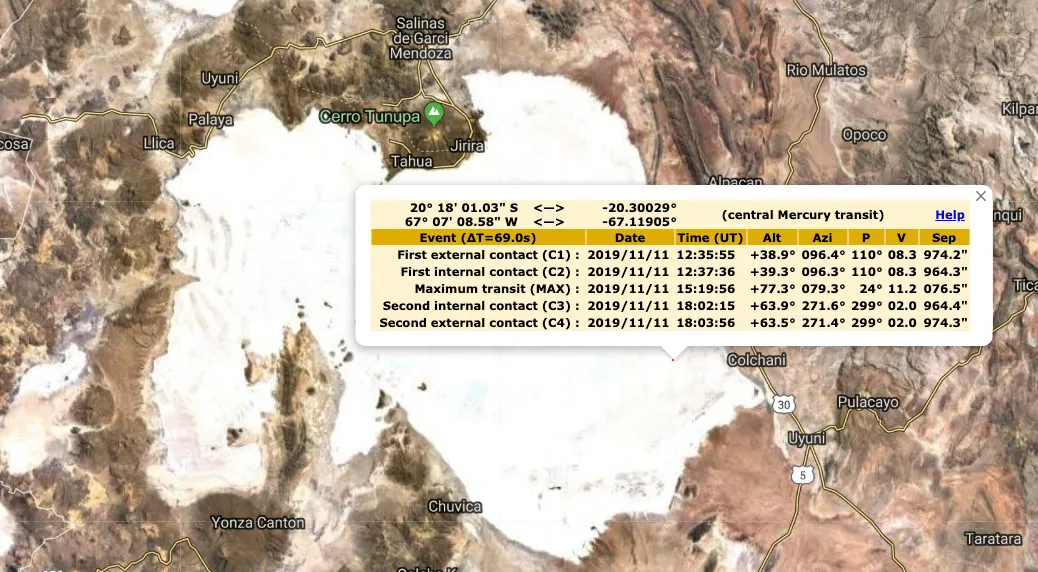
An extension of the Atacama desert, southern Bolivia has super-dark and clear skies (the rainy season starts in January).
If you’ve ever wanted to explore the mesmerising Uyuni salt flats, the world’s largest, November would be a prime time.
Chimu Adventures organise car-driver-guide tours and are well used to the demands of astronomers and astrophotographers. Take your own telescope.
3
Canary Islands, Spain
Entire transit visible from 12:35-18:03
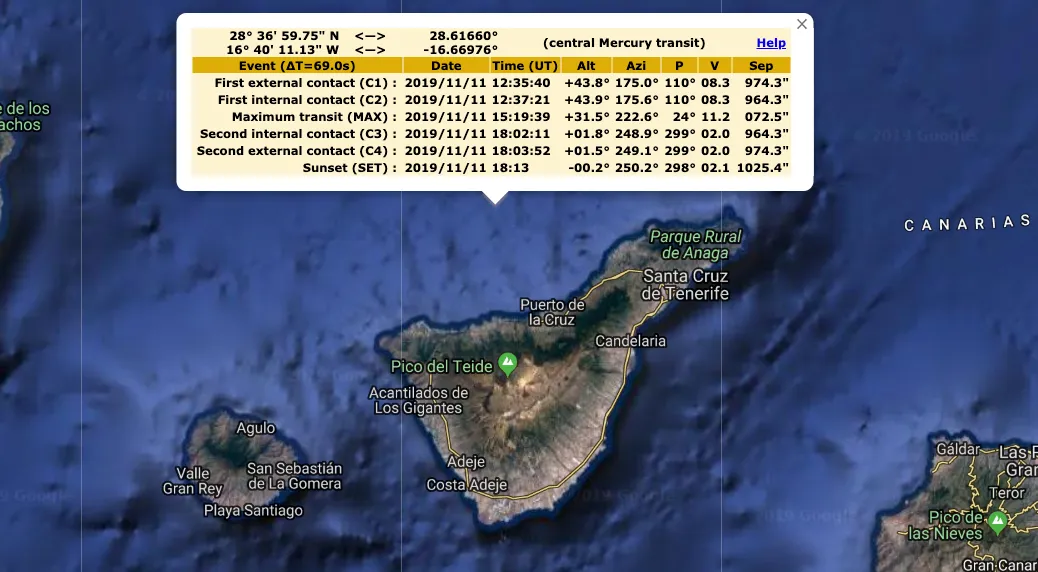
Slightly closer to home and easy to get cheap flights to, any of the Canary Islands – Tenerife, Fuerteventura, Gran Canaria, Lanzarote and La Palma – would be fine.
However, Tenerife has a huge solar observatory that does tours and, nearby in Teide National Park 2,152 m above sea level, the Parador de Cañadas del Teide hotel, which has its own telescopes.

